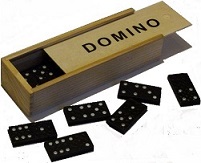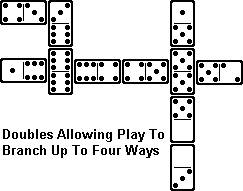|
||||||||||||||||||||||||||||||||||||||||
|
|
||||||||||||||||||||||||||||||||||||||||
|
Domino Basics
IntroductionHere is a basic introduction to Western domino gameplay, describing the common methods and procedures found in most domino games.Standard Western dominoes are small rectangular tiles marked with a number of circular dots (known as spots or pips) on either of their two ends, divided by a central line (known as the bar, divider, or centre). They come in a variety of sizes but commonly, standard Western dominoes are sized about two-inches long, one-inch wide, and 3/8-inch thick. This is small enough to be held in the hand, and large enough to clearly indicate gameplay and to be easily placed and manipulated. They are also thick enough to stand on any of their edges. An individual domino tile is conventionally referred to by the number of spots on each end, with the lowest spotted number usually taken first. So, a domino tile marked with a 3 and a 5 on either end is referred to as a "three-five". When both ends of a tile are marked with the same spotted number, they are called doubles or doublets). So, a tile marked on both ends with six spots is called a "double-six". Domino tiles marked with two differing values are called singles. Tiles that share a common number of
spots on one end are said to be of the same suit. In a Double-Six
set, for example, 1–0, 1–1, 1–2, 1–3, 1–4, 1–5, and 1–6 all belong
to the suit of one. All singles belong to two suits. The 1–2, for
example, belongs to the suit of one and the suit of two. All doubles
belong to one suit only by this definition. An alternate definition
of suit allows all dominoes to have two suits, by counting the set
of all doublets as an additional suit. Tiles which have ends with the same number of dots are members of the same "suit". In a Double-Six set, there are seven suits (blank, 1, 2, 3, 4, 5, 6), each with seven members. 0-5, 1-5, 2-5, 3-5, 4-5, 5-5, & 5-6 make up the "fives" suit, for instance. Except for the doubles, each tile belongs to two suits.
General Domino Game PlayRules and Convention Variations Rules and conventions for domino games vary greatly between different players and in different locations or regions of the world. Remember, there are no officially set rules for domino games and some players may play a different rule than the one you are used to. You may play any variation on the rules you like, but remember it is important all players agree on the rules and conventions of the game before you start play. The following text describes a number of commonly found rules and conventions for domino-play found in most domino games. Most rules are interchangeable between most domino games, so feel free to play the rules you and your fellow domino players are comfortable with, just make sure everyone is in agreement first. Types of Domino Game Domino games can be divided into a number of categories defined by their gameplay. The following are the main categories of domino game you may come across.
Shuffling the DominoesAt the start of any hand, round or game of dominoes, the tiles should be shuffled, so no player knows where any particular tile is, and may not select it or know who else has it. Typically, all the tiles are turned facedown on the flat playing surface, then repeatedly mixed and moved around at random by a player using the flat of their hand(s). A player's hand must not remain on any of the same tiles during the shuffling and must be clearly shown to be raised and moved about during the process. The shuffled domino-tiles (or bones) are commonly known as the boneyard. The player who shuffles the dominoes may be determined in a number of ways. The following are common among domino players:
Selecting the First Player and Order of PlayThe first player to make a play in a domino game may be determined in a number of conventional ways. The following are all common ways to determine the first player and are well known among domino players and with many domino games.
In Europe and North America order of play usually passes in turn to the next left player, in a clockwise direction. Many Latin American and Carribean countries play in an anticlockwise direction. Drawing Tiles for a HandIn domino games using hands of tiles, players may take it in turn to draw the required number of tiles from the boneyard or they may all draw their tiles at the same time in a haphazard scramble. In a multiplayer game with hands of dominoes, players set their tiles on edge facing themselves so they may see the values of their tiles, but with no other player able to see the values of any other player's tiles. All players should be able to see how many tiles are left in any other player's hand at all times during play. Often tiles are left remaining in the boneyard which may come into play during the course of a hand or round. Card-type domino games may have a dealer who deals out players hands consisting of a number of tiles which may vary according to the specific game. Determining The First Tile Played In a multiplayer domino game using hands of dominoes, the first tile played may be determined in a number of ways. The following are common among domino players:
Playing the first tile in a round, hand or game may be known as setting, leading, downing, or posing the first tile, and the tile set, led, downed, or posed is referred to as the set, the lead, the down, or the pose. This first set is also known as smacking the tile or bone down. Playing Subsequent TilesTypically in a domino game, after the initial tile has been laid, the
open ends of the dominoes in play may be used for placing subsequent
connecting tiles with a If at any point during play you find your layout leading off outside your playing area (or even if you just feel like it) you may set a tile at a right-angle to an open ended tile creating an "L" shape in your line-of-play. Drawing Subsequent Tiles During PlayDuring play in a domino game using hands a situation may arise in which a player may be unable to play a domino from their hand onto the layout. In this situation, depending on the game being played, a player may do one of two things:
Most game rules for dominoes allow players to draw tiles until the boneyard is empty, but some may not allow the last two tiles to be drawn, with the winner of a hand or round scoring the point total remaining in the boneyard. The End of a Hand, Round or Game The end of a multiplayer domino game using hands is usually determined by either a player playing the last domino in their hand or when no player is able to play any further domino-tiles onto the layout. When no further tiles may be played by any player, the game is said to have been "blocked". This is also known as a lockdown and the players are said to have been "locked out". When a player plays his last tile they traditionally announce it by calling out "domino" and the other players are said to have been dominoed. In many block domino games the winner of a hand or round scores the total number of pips left in the other players' hands. Doubles may be counted as one or two, so double-six could score either 6 or 12 points and double-four could score 4 or 8. Sometimes a double-blank is scored as 14 points but often scores just 0. In a game consisting of a number of hands or rounds, players record their ongoing scores on a score-sheet and the first player to score over a pre-agreed total (say 100, 200, or 250 points), wins the game.
|
|||||||||||||||||||||||||||||||||||||||
|
Copyright © 2016 Stormdark I.P. and Media. All rights reserved. www.domino-play.com This site is for personal use only and content may not be copied or reproduced in any form for any purpose. Terms & Conditions Advertising |
||||||||||||||||||||||||||||||||||||||||



 matching suit value on one end. Doubles are
often set widthways with the long side connected to one of the short sides
of an open tile which must have a matching suit. In many domino
games only the long side may be used to set a subsequent matching domino
against. However, some games allow play on any one of the four sides
of a double, allowing the domino line-of-play to branch off in four
directions.
matching suit value on one end. Doubles are
often set widthways with the long side connected to one of the short sides
of an open tile which must have a matching suit. In many domino
games only the long side may be used to set a subsequent matching domino
against. However, some games allow play on any one of the four sides
of a double, allowing the domino line-of-play to branch off in four
directions.